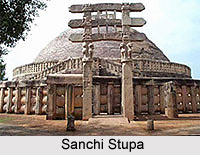 The Buddhist art in sculptures can be marked with special features and distinct characters of its own. When King Ashoka, adopted the Buddhist philosophy, he then immediately followed the mission to spread the teachings of this faith in all possible directions. This resulted in the creation of many stupas or dome-shaped monuments along with a polished stone pillar midway through the third century BC. The Stupas contained a central chamber, in which the relics of the Buddha were placed. These constructions, which served as edicts can be easily noticed in Buddhist monuments, created in many places of India.
The Buddhist art in sculptures can be marked with special features and distinct characters of its own. When King Ashoka, adopted the Buddhist philosophy, he then immediately followed the mission to spread the teachings of this faith in all possible directions. This resulted in the creation of many stupas or dome-shaped monuments along with a polished stone pillar midway through the third century BC. The Stupas contained a central chamber, in which the relics of the Buddha were placed. These constructions, which served as edicts can be easily noticed in Buddhist monuments, created in many places of India.
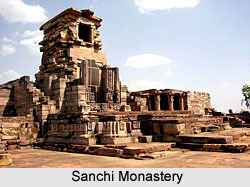 The architecture can be clearly seen in the monuments like the stupas, monolithic Ashokan pillar, temples, monasteries and sculptural wealth. The Sanchi hill goes up in shelves with Stupa 2 situated on a lower shelf, Stupa 1, Stupa 3, the 5th century Gupta Temple No.17 and the 7th century temple No. 18 are on the intermediate shelf and a later monastery is on the crowning shelf. Sir John Marshall hailed the adjacent Gupta temple no.17 as one of the most rationally organized structures in Indian architecture. The railing surrounding Stupa 2, carved with anionic representations of the Buddha, was added in the later 2nd century BC under the Satavahanas.
The architecture can be clearly seen in the monuments like the stupas, monolithic Ashokan pillar, temples, monasteries and sculptural wealth. The Sanchi hill goes up in shelves with Stupa 2 situated on a lower shelf, Stupa 1, Stupa 3, the 5th century Gupta Temple No.17 and the 7th century temple No. 18 are on the intermediate shelf and a later monastery is on the crowning shelf. Sir John Marshall hailed the adjacent Gupta temple no.17 as one of the most rationally organized structures in Indian architecture. The railing surrounding Stupa 2, carved with anionic representations of the Buddha, was added in the later 2nd century BC under the Satavahanas.
The site is one of the most provoking in India, and a good base for a number of interesting bicycle excursions. The Sanchi stupas are noteworthy for their gateways as they contain ornamented depiction of incidents from the life of Buddha and his previous incarnations, "Bodhisattvas", as described in the Jataka tales. Below the hill, the Archaeological Survey of India Museum houses some of the earliest known stone sculptures in Indian art from the 3rd to the 1st century BC.
History
During the Sunga times, several edifices were raised at Sanchi and its surrounding hills. The most famous of these monuments, the Sanchi Stupa 1 was originally built by the Mauryan Emperor Ashoka, the then governor of Ujjayini. The Ashokan stupa was enlarged and faced with stones and decorated with balustrades, staircases and a harmika on the top. The reconstruction of Temple 40 and erection of Stupas 2 and 3 also seem to date back around the same time. During the 1st century BC, the Andhra-Satavahanas, elaborately carved the gateways to Stupa 1. From the 2nd to the 4th Century AD, Sanchi and Vidisha came under the Guptas.
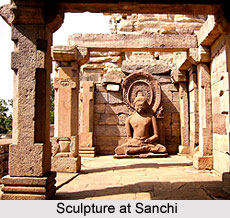 During the Gupta period some temples were built and sculptures were added. Shrines and monasteries were also constructed at the site during seventh and twelfth centuries AD. The Buddha`s surrounding Stupa 1 is not contemporary with the Stupa but belong to the Gupta period in mid 5th century AD. The monastery and the temple with the tall pillars adjacent to Stupa 1 and the temple near the monastery on the crowning shelf illustrate the evolution of the architectural form after the 5th century Gupta temple.
During the Gupta period some temples were built and sculptures were added. Shrines and monasteries were also constructed at the site during seventh and twelfth centuries AD. The Buddha`s surrounding Stupa 1 is not contemporary with the Stupa but belong to the Gupta period in mid 5th century AD. The monastery and the temple with the tall pillars adjacent to Stupa 1 and the temple near the monastery on the crowning shelf illustrate the evolution of the architectural form after the 5th century Gupta temple.
After the 14th century, however, Sanchi remained deserted till 1818. But afterwards General Taylor, a British officer, discovered it. Later in 1912, Sir John Marshall, the Director General of Archaeology, ordered the restoration work at the site and established an archaeological museum in 1919. This was later transformed into the present site museum at Sanchi.
Site & Architecture
One of the important things of attention is that the Buddha is not represented at all through figures at Sanchi. But instead through various symbols of his teachings he is described, as it was the tradition in the early period of Buddhism. The flower of lotus represents the birth of Buddha, the big tree signifies his enlightenment, the Wheel represents his first sermon and the Stupa finally represents his nirvana or salvation. The footprints and the throne are used to denote the Buddha`s presence. Some of the important monuments in Sanchi are:
The Great Stupa No.1
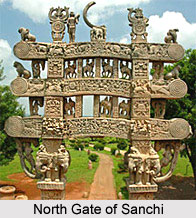 This stupa is about 36.5mts in diameter and 16.4 mtrs in height it is one of the oldest stone structures in India. With a massive hemispherical dome, the stupa stands majestically. Though originally built by Emperor Ashoka, as an earthen stupa, it was rebuilt in the 3rd and 2nd centuries BC. The last of the additions to this remarkable stupa are the elaborate and richly carved four gateways or Toranas. The first of the four gateways to be erected was the one at the Southern Entrance, followed, in chronological order by the Northern, the Eastern and the Western Gateways.
This stupa is about 36.5mts in diameter and 16.4 mtrs in height it is one of the oldest stone structures in India. With a massive hemispherical dome, the stupa stands majestically. Though originally built by Emperor Ashoka, as an earthen stupa, it was rebuilt in the 3rd and 2nd centuries BC. The last of the additions to this remarkable stupa are the elaborate and richly carved four gateways or Toranas. The first of the four gateways to be erected was the one at the Southern Entrance, followed, in chronological order by the Northern, the Eastern and the Western Gateways.
The Southern Gateway: It is crowned by a wheel of law, illustrates the miracle associated with the Buddha as told in the Jataka tales. It hence, reveals the birth of Gautam in a series of dramatically rich carvings.
The Eastern Gateway: It depicts the young prince, Gautam, leaving his father`s place, renouncing worldly life to seek enlightenment. The inner face of the right pillar portrays the dream of Maya, the mother of Buddha, when she conceived him.
The Western Gateway: It depicts the seven incarnations of the Buddha, four represented by trees and three by stupas; the Buddha preaching his first sermon at the Deer Park, Sarnath and the Chhaddanta Jataka tale.
Stupa No. 2
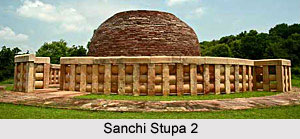 It dates back to the 2nd century BC and stands at the very edge of the hill and its most striking feature is the stone balustrade that surrounds it.
It dates back to the 2nd century BC and stands at the very edge of the hill and its most striking feature is the stone balustrade that surrounds it.
Stupa No.3
This structure belongs to the period between 150-140 BC and is situated northeast of the Great Stupa, where the relics of Sariputra and Mahamogalana, the two famous disciples of the Buddha were found in its inner most chambers. The hemispherical dome is crowned, as a mark of its special religious significance, with an umbrella of polished stone. It has only one gateway.
Ashoka Pillar
Erected during the 3rd Century BC, with its four lion head stump, it is situated close to the Southern Gateway of the Great Stupa. A unique feature of this pillar is its brilliant polish.
The Gupta Temple
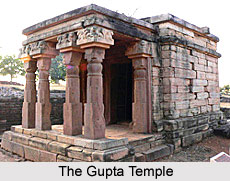 Erected during the 4th Century AD, it is now in ruins, but According to some historians, it is one of the earliest known examples of temple architecture in India. A simple flat roofed chamber characterizes it & a pillared porch constructed at front.
Erected during the 4th Century AD, it is now in ruins, but According to some historians, it is one of the earliest known examples of temple architecture in India. A simple flat roofed chamber characterizes it & a pillared porch constructed at front.
The Great Bowl
It is carved out of one block of stone, contained food that was distributed amongst the monks of Sanchi.
The Archaeological Survey of India Museum
It is situated at the entrance to the monument and it exhibits findings and remains of the excavated site. Among these are caskets, pottery, and parts of gateways, lion capital of the Ashokan Pillar and images.
Temple 18
It is a chaitya hall, situated just in front of the Southern Gateway of the Great Stupa. It is comparatively recently built around 7th Century A.D and its style of architecture closely resembles with the rock-cut chaitya halls at Karla Caves in Maharashtra.
The Monastery and Temple 45
It was built during the period of the 7th and 11th centuries and more developed styles of architecture are marked from it. The doorways of this construction are ornamented, with the image of Buddha in an oval Halo.




